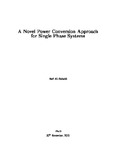A Novel Power Conversion Approach for Single Phase Systems
| dc.contributor.supervisor | AHMED, MOHAMMED ZAKI | |
| dc.contributor.author | AL-ZUBAIDI, SAIF THAMER FADHIL | |
| dc.contributor.other | School of Engineering, Computing and Mathematics | en_US |
| dc.date.accessioned | 2015-12-18T14:23:28Z | |
| dc.date.available | 2015-12-18T14:23:28Z | |
| dc.date.issued | 2015 | |
| dc.identifier | 10340398 | en_US |
| dc.identifier.uri | http://hdl.handle.net/10026.1/3971 | |
| dc.description.abstract |
A novel single phase rectification technique with a new architecture and control scheme is proposed. The new rectifier consists of switched capacitor branch in parallel with the diode bridge rectifier. The switched capacitor branch includes a capacitor and a bidirectional switch arranged in series so the switch can control the charging and discharging of the capacitor. The control strategy is carefully designed to ensure the output voltage of the rectifier is above a chosen threshold level and to maintain high input power factor with reduced line current harmonics. Circuit configuration, design parameters, principles of operation and the mathematical analysis are presented. The new architecture provides a reduction in the size of the DC side capacitor. This reduction can be as low as less than 10% of the size of the typical smoothing capacitor in the conventional single phase rectifier. The proposed concept is verified by the experimental results over a range of case studies. A novel buck-boost DC-DC converter architecture is also proposed. This converter utilises the close inversely-coupled inductors topology in both its conversion stages (buck and boost). The new converter aims to reduce the switching noise that usually accompanies the buck and boost circuits. This can be done by maintaining a continuous flow of current in both converter stages which results in a large reduction in the back e.m.f induced in the main inductor and thus reduces the switching noise. The new converter architecture also provides a unique design of the passive clamped circuit. This circuit is used to recycle the leakage energies of the coupled inductors which results in an efficiency improvement of the converter and to limit the voltage stress on the power switches. Circuit con figuration, principles of operation and the transfer function are presented. The proposed concept is verified by the experimental and the simulated results of a range of case studies. The highest achieved efficiency observed in the experiments was 97:7%. | en_US |
| dc.description.sponsorship | MOHESR | en_US |
| dc.language.iso | en | en_US |
| dc.publisher | Plymouth University | en_US |
| dc.subject | AD-DC power conversion for single phase systems | en_US |
| dc.title | A Novel Power Conversion Approach for Single Phase Systems | en_US |
| dc.type | Thesis | |
| plymouth.version | Full version | en_US |
| dc.identifier.doi | http://dx.doi.org/10.24382/4791 |
Files in this item
This item appears in the following Collection(s)
-
01 Research Theses Main Collection
Research Theses Main


